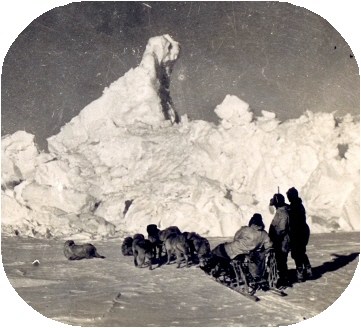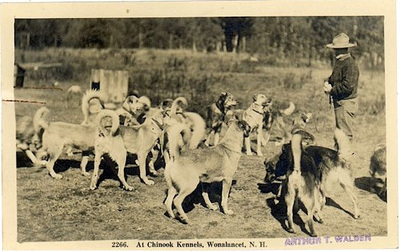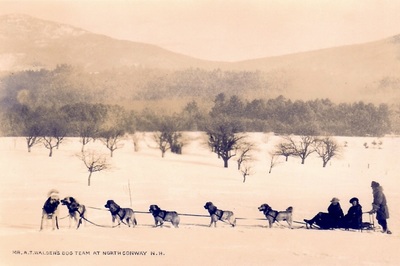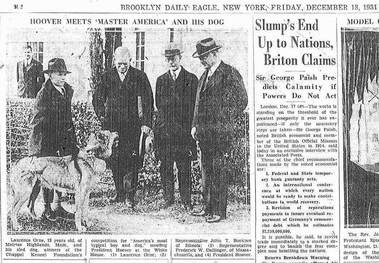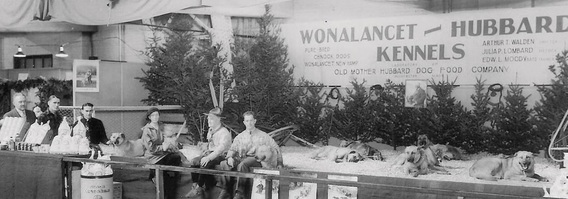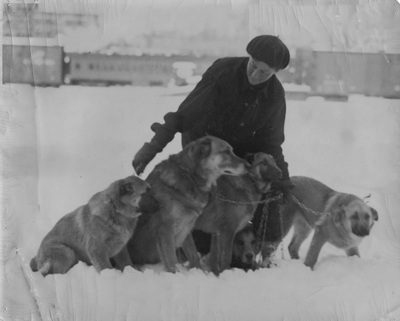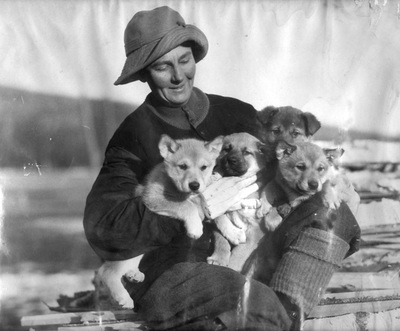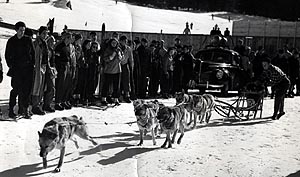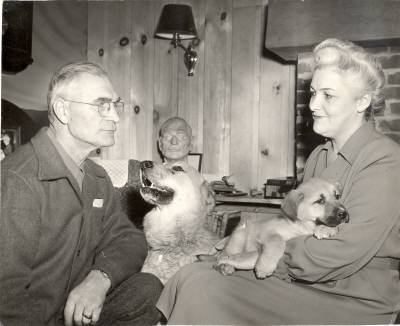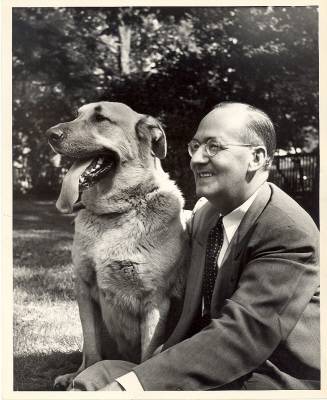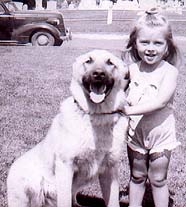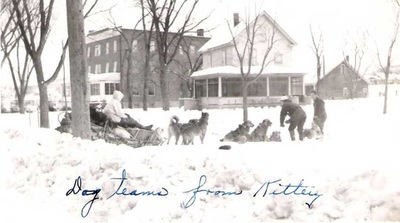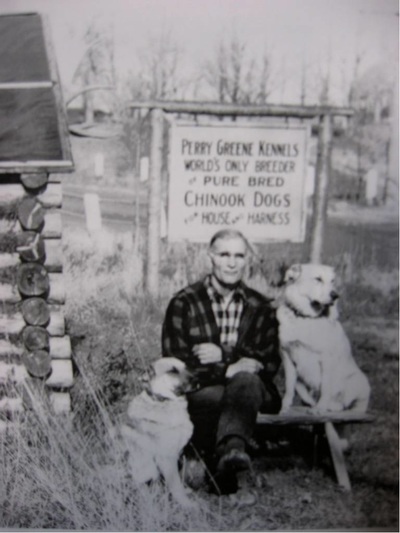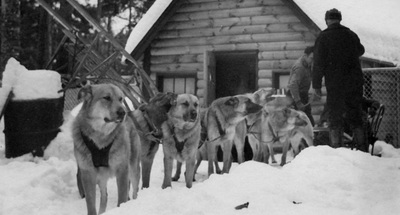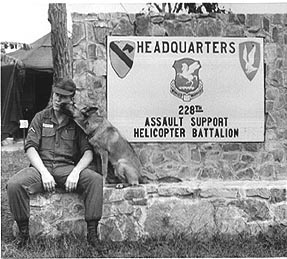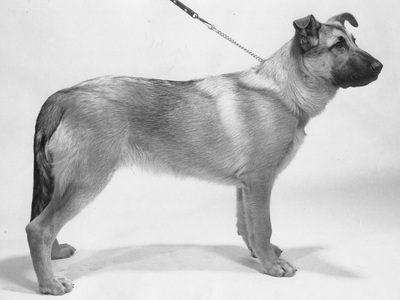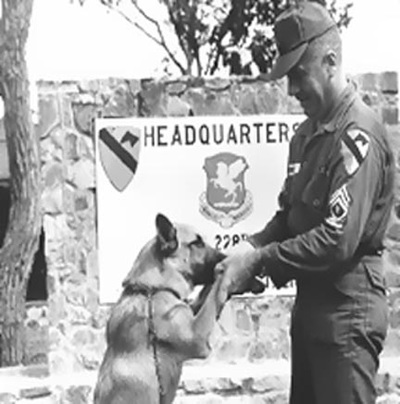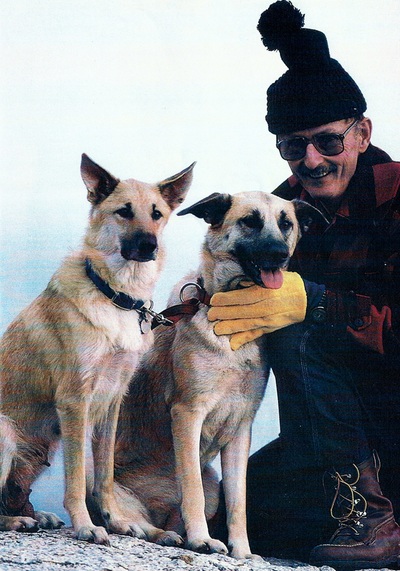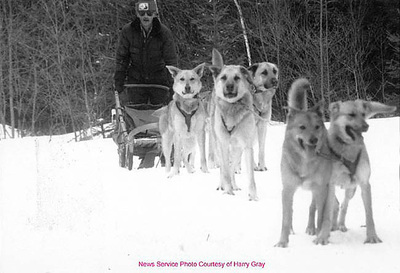Did you know? The Chinook is the Official State Dog of New Hampshire?
For further historical information on the Chinook Breed:
Tour our Chinook History Project website for rare and never seen documents and photos of the fascinating origins of the Chinook Breed. Historic photos galore!
Visit CCA's Special Edition of The Chinook Advocate featured in the 2017 AKC Gazette, honoring Chinook's 100th birthday and the rich history of this remarkable Breed.
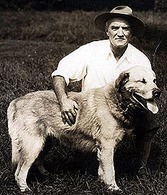 Arthur Walden and Chinook
Arthur Walden and Chinook
A Brief History of the Chinook
The Chinook was the inspiration of Arthur Treadwell Walden, a sled-dog driver, author, explorer, and innkeeper from the village of Wonalancet, nestled in north central New Hampshire at the foot of the White Mountains. Walden created a distinctly tawny, American sled dog that had power, endurance and speed, along with a friendly, gentle nature.
Chinook and his Family
Walden's foundation dogs for the Chinook Breed were descendants of Admiral Peary's Greenland husky lead dog, Polaris, and a mastiff-type farm dog who produced a litter of three pups on January 17, 1917, in New Hampshire. The pups were named Rikki, Tikki and Tavi after the mongoose in Rudyard Kipling's The Jungle Book. One of these pups was eventually called "Chinook" after a sled dog Walden had used while freighting supplies for gold miners in the Yukon. This dog was the foundation of the Chinook breed to which all Chinooks are related.
Chinook grew to be 100 pounds. In Walden's book Harness and Pack, Walden described Chinook as "a large tawny yellow dog, a half-bred Eskimo, with dark ears and muzzle. Chinook was known not only as a wonderful sled dog, but also for his gentle disposition toward children.
Descendants of Chinook would later be called "Chinooks" in honor of the foundation sire. Check out this video, "Chinook's Children" a silent movie short of the time.
Walden and his dog sled team, with Chinook in lead, were credited with bringing the sport of sled dog racing to New England. In 1924, Walden founded the New England Sled Dog Club, the oldest club of its kind still in operation today. In 1927, Walden was appointed to head the Dog Department for Admiral Richard Byrd's first Antarctic Expedition (BAE I). Walden and his sixteen Chinook dogs were described by Admiral Byrd as the backbone of the expedition transport. In fact, in 1931, Arthur Walden received the Congressional Medal for his part in Admiral Richard Byrd's Antarctic Expedition.
Unfortunately, it was in Antarctica that Chinook, nearing his twelfth birthday, was lost. Reports of Chinook's death made news around the world and many mourned the loss of one of the greatest lead dogs in history. At Walden's request, Route 113A from Tamworth to Wonalancet, New Hampshire, now bears the name "Chinook Trail" to honor his famous lead dog.
The Chinook was the inspiration of Arthur Treadwell Walden, a sled-dog driver, author, explorer, and innkeeper from the village of Wonalancet, nestled in north central New Hampshire at the foot of the White Mountains. Walden created a distinctly tawny, American sled dog that had power, endurance and speed, along with a friendly, gentle nature.
Chinook and his Family
Walden's foundation dogs for the Chinook Breed were descendants of Admiral Peary's Greenland husky lead dog, Polaris, and a mastiff-type farm dog who produced a litter of three pups on January 17, 1917, in New Hampshire. The pups were named Rikki, Tikki and Tavi after the mongoose in Rudyard Kipling's The Jungle Book. One of these pups was eventually called "Chinook" after a sled dog Walden had used while freighting supplies for gold miners in the Yukon. This dog was the foundation of the Chinook breed to which all Chinooks are related.
Chinook grew to be 100 pounds. In Walden's book Harness and Pack, Walden described Chinook as "a large tawny yellow dog, a half-bred Eskimo, with dark ears and muzzle. Chinook was known not only as a wonderful sled dog, but also for his gentle disposition toward children.
Descendants of Chinook would later be called "Chinooks" in honor of the foundation sire. Check out this video, "Chinook's Children" a silent movie short of the time.
Walden and his dog sled team, with Chinook in lead, were credited with bringing the sport of sled dog racing to New England. In 1924, Walden founded the New England Sled Dog Club, the oldest club of its kind still in operation today. In 1927, Walden was appointed to head the Dog Department for Admiral Richard Byrd's first Antarctic Expedition (BAE I). Walden and his sixteen Chinook dogs were described by Admiral Byrd as the backbone of the expedition transport. In fact, in 1931, Arthur Walden received the Congressional Medal for his part in Admiral Richard Byrd's Antarctic Expedition.
Unfortunately, it was in Antarctica that Chinook, nearing his twelfth birthday, was lost. Reports of Chinook's death made news around the world and many mourned the loss of one of the greatest lead dogs in history. At Walden's request, Route 113A from Tamworth to Wonalancet, New Hampshire, now bears the name "Chinook Trail" to honor his famous lead dog.
There have been a number of notable events occurring throughout the Chinook's history:
- In 1931, a Chinook named Paugus and his young owner, Lawrence Orne, won a photo contest as "America's Most Typical Boy and Dog." The prize was $250.00 and a handshake from President Hoover and their portraits were painted.
- After the Byrd expeditions, Walden fell on hard times forcing him to sell the Chinook Kennels to Milton Seeley. The dogs were moved to a new location about a mile down the road from the Walden homestead. From what historic pedigrees remain, it appears that the modern Chinook breed may be descended from Walden's breedings through just three dogs - Jock, Hootchinoo, and Zembla - who were sold by Walden to kennel partner Julia Lombard prior to embarking on his Antarctic expedition.
Perry Greene Era Chinooks
In 1940, Perry Greene and his wife Honey purchased the Chinooks from Lombard and moved them to the Perry Greene Kennel in Waldoboro, Maine. In 1941, Perry Greene and his Chinook team made a 502-mile journey in 90 hours, the longest sled dog trek made within the US at that time. The Greenes promoted the Chinooks for many years but sold only males or spayed females. They became the sole breeder of the Chinook, creating a great deal of mystique and legend about the breed and its history. When Perry Greene died in 1963, Honey Greene tried to continue breeding Chinooks, but by 1965 the Guinness Book of World Records recorded the Chinook - for the first of three times - as the rarest dog, with only 125 dogs alive and the number dropping rapidly.
In 1940, Perry Greene and his wife Honey purchased the Chinooks from Lombard and moved them to the Perry Greene Kennel in Waldoboro, Maine. In 1941, Perry Greene and his Chinook team made a 502-mile journey in 90 hours, the longest sled dog trek made within the US at that time. The Greenes promoted the Chinooks for many years but sold only males or spayed females. They became the sole breeder of the Chinook, creating a great deal of mystique and legend about the breed and its history. When Perry Greene died in 1963, Honey Greene tried to continue breeding Chinooks, but by 1965 the Guinness Book of World Records recorded the Chinook - for the first of three times - as the rarest dog, with only 125 dogs alive and the number dropping rapidly.
- In 1966, Boeing Helicopters-Vetrol Division obtained a Chinook named Charger as a mascot, and sent Charger to the 228th base at An Khe, South Vietnam. Charger never made it back.
- The remaining Chinook dogs came to be kenneled at the Sukeforth (Sukee) Kennels in Warren, Maine. In 1981, Neil and Marra Wollpert went looking for the Chinook and found Kathy Adams working at the Sukee Kennels, trying to save the breed from extinction. Only twenty-eight dogs remained, and most were elderly or neutered. The remaining eleven breedable Chinook dogs were divided between the Wollperts of Ohio (Singing Woods Chinooks), Kathy Adams of Maine (Alder Patch Chinooks), and Peter Abrahams (Yokayo Chinooks) of California.
- From 1984 to 1994, Harry Gray's Northdown Kennel was also influential in preserving breeding stock. Chinooks who passed thru Harry's Northdown Kennel are found in all of today's pedigrees.
- In February, 1990, Harry Gray completed a 325-mile "Trek for Life" with his team of Chinook sled dogs. Harry and his Chinooks traveled from Greenville, ME to Wonalancet, NH in order to raise awareness and funds for the organ donor programs of the Maine and New Hampshire Kidney Foundations.
- In June, 2009, after lobbying by the students of Lurgio Middle School, Governor John Lynch signed a bill making the Chinook the State Dog of New Hampshire.
- With dedication and careful breeding, the Chinook numbers have been steadily increasing. In 2001, the Chinook was added to the AKC's Foundation Stock Service and, as of January, 2013, when Chinooks were fully recognized by AKC, there were 813 Chinooks registered. The modern Chinook is still a hard-working dog that excels in venues such as sledding, packing, skijoring, obedience, agility and herding. But above all else, the Chinook is cherished as a family companion.
Chinook Club of America, Inc. Copyright 2021
